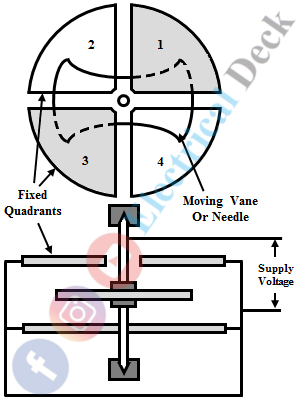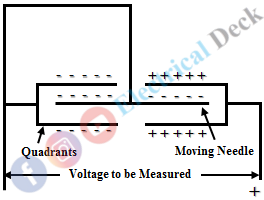In the last article, we have seen about electrostatic instruments. An electrostatic instrument is basically a voltmeter that works on the principle of static electric field. They are used for voltage measurement (especially for high voltages) but can also be used for measuring current and power with the additional arrangement.
The electrostatic voltmeters are of two types,- Quadrant type electrostatic voltmeter (used up to 20kV)
- Attracted disc type electrostatic voltmeter (used up to 500kV)
Quadrant Type Electrostatic Voltmeter :
The quadrant electrometer consists of four metallic quadrants and a double sector shaped moving vane or needle as shown in the below figure.
Quadrants 1 and 2 lie above the needle and quadrants 3 and 4 below the needle. The needle is suspended in the air gap between the two sets of quadrants. Silver quartz or phosphor bronze thread is used for the suspension.
The needle carries a mirror that reflects the light focused on it on the scale. Sometimes, instead of this suspension, a spindle is placed on which the needle is mounted. Also, a spring is attached to the spindle, which provides the control torque.
A resistance of high value should always be connected in series with these types of instruments in order to prevent a short circuit when the supply is given. When a potential V is applied across the fixed quadrants and moving vane, a static electric field is set up between them and a force of attraction exerts on the needle. Hence, the needle starts rotating due to the deflecting torque Td and shows the deflection.
There are two types of connections in a quadrant electrometer. They are,- Heterostatic connection, and
- Idiostatic connection.
Heterostatic Connection :
In this type of connection voltage to be measured is applied across the fixed quadrants. A high tension (HT) battery is used to charge the moving needle more positively than the fixed quadrants (i.e., voltage to be measured). The heterostatic connection is shown below.
Here the fixed quadrants are charged in such a way that, the diagonal pair will be charged oppositely. The needle will be charged with positive polarity with help of an HT battery. Here the deflecting torque is produced due to the attraction force between the left quadrant and right moving sector and the repulsion force between the right quadrant and left moving sector.
Idiostatic Connection :
In this type of connection, there is no additional external voltage. The moving needle is connected to any pair of quadrants directly as shown below.
Here, the moving needle is charged with negative polarity. Due to the negative polarity of the needle, there exists a force of attraction on the needle by the two positively charged quadrants i.e., on the right side, and these two forces will cancel each other. Similarly, there will be a repulsive force on the needle by the two quadrants on the left side, and these two forces will cancel each other.
But, due to attraction force on the part of a needle lying on the left side, and a repulsive force on the part of a needle lying on the right side causes the production of deflecting torque and moves the needle. This movement causes to move the pointer attached to it.
If the instrument is spring controlled and used for measuring low voltages, heterostatic connection is most suitable because, for idiostatic, the deflection obtained is proportional to the square of applied voltage (i.e., voltage to be measured) and for low voltages, the deflection will be small.
Whereas in the case of heterostatic, deflection is proportional to the product of voltage applied and dc HT voltage, thus the voltage to the needle is very high and the deflection obtained will be considerably large even for low voltages.
Kelvin Multicellular Voltmeter :
It is one of the quadrant type electrostatic voltmeters. It consists of a number of moving needles (vanes) with one quadrant as shown below. The measuring range of this type of instrument is 100 to 1000 volts.
The moving needle is suspended through phosphor-bronze suspension with a coach spring to prevent vibrations. An oil-immersed damping vane provides the required damping. Here, the range of the instrument can be increased or decreased by changing the number of cells.
To measure large voltages number of cells required is less and vice versa. So that the required deflecting force can be produced by using more cells while measuring small voltages.




